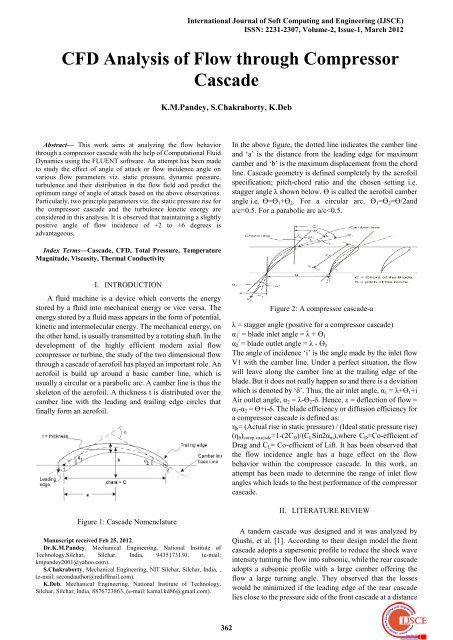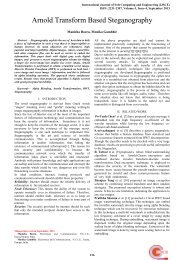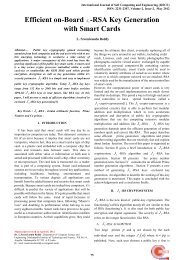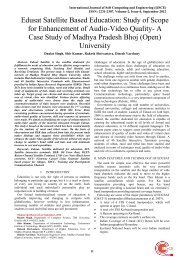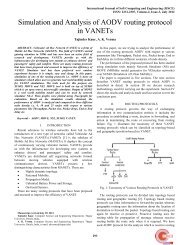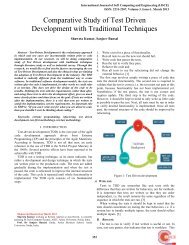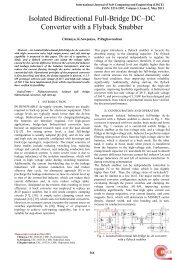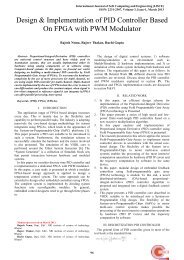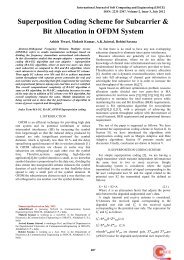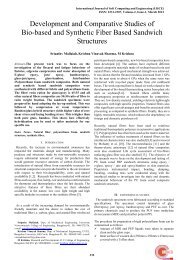CFD Analysis of Flow through Compressor Cascade - International ...
CFD Analysis of Flow through Compressor Cascade - International ...
CFD Analysis of Flow through Compressor Cascade - International ...
You also want an ePaper? Increase the reach of your titles
YUMPU automatically turns print PDFs into web optimized ePapers that Google loves.
<strong>International</strong> Journal <strong>of</strong> S<strong>of</strong>t Computing and Engineering (IJSCE)<br />
ISSN: 2231-2307, Volume-2, Issue-1, March 2012<br />
<strong>CFD</strong> <strong>Analysis</strong> <strong>of</strong> <strong>Flow</strong> <strong>through</strong> <strong>Compressor</strong><br />
<strong>Cascade</strong><br />
K.M.Pandey, S.Chakraborty, K.Deb<br />
<br />
Abstract— This work aims at analyzing the flow behavior<br />
<strong>through</strong> a compressor cascade with the help <strong>of</strong> Computational Fluid<br />
Dynamics using the FLUENT s<strong>of</strong>tware. An attempt has been made<br />
to study the effect <strong>of</strong> angle <strong>of</strong> attack or flow incidence angle on<br />
various flow parameters viz. static pressure, dynamic pressure,<br />
turbulence and their distribution in the flow field and predict the<br />
optimum range <strong>of</strong> angle <strong>of</strong> attack based on the above observations.<br />
Particularly, two principle parameters viz. the static pressure rise for<br />
the compressor cascade and the turbulence kinetic energy are<br />
considered in this analysis. It is observed that maintaining a slightly<br />
positive angle <strong>of</strong> flow incidence <strong>of</strong> +2 to +6 degrees is<br />
advantageous.<br />
In the above figure, the dotted line indicates the camber line<br />
and „a‟ is the distance from the leading edge for maximum<br />
camber and „b‟ is the maximum displacement from the chord<br />
line. <strong>Cascade</strong> geometry is defined completely by the aer<strong>of</strong>oil<br />
specification; pitch-chord ratio and the chosen setting i.e.<br />
stagger angle λ shown below. ϴ is called the aer<strong>of</strong>oil camber<br />
angle i.e. ϴ=ϴ 1 +ϴ 2 . For a circular arc, ϴ 1 =ϴ 2 =ϴ/2and<br />
a/c=0.5. For a parabolic arc a/c
<strong>CFD</strong> <strong>Analysis</strong> <strong>of</strong> <strong>Flow</strong> <strong>through</strong> <strong>Compressor</strong> <strong>Cascade</strong><br />
<strong>of</strong> 20% pitch in pitch-wise direction without either axial<br />
spacing or overlapping in axial direction. Their 2D numerical<br />
test results show that, with the inflow mach no. <strong>of</strong> 1.25 and the<br />
turning angle <strong>of</strong> 52, the total pressure loss coefficient <strong>of</strong> the<br />
tandem cascade reaches 0.106, and the diffusion factor 0.745,<br />
and by adopting the finding and concerning the best relative<br />
position <strong>of</strong> the front to the rear cascade <strong>of</strong> tandem cascade, a<br />
high loaded fan stage with rotor tip speed <strong>of</strong> 495.32 m/s has<br />
successfully been developed. Bakhtar and So [2] studied the<br />
nucleating flow <strong>of</strong> steam in a cascade <strong>of</strong> supersonic blading by<br />
the time-marching method. This investigation follows the<br />
earlier experiment in which a case <strong>of</strong> 2D nucleating flow <strong>of</strong><br />
steam in a cascade was investigated, but there were some<br />
numerical errors with the particular configuration. To discard<br />
the errors associated with the solution they assumed the bulk<br />
<strong>of</strong> the flow to be inviscid. They came to the conclusion that a<br />
finer mesh can be embedded into selected regions <strong>of</strong> the basic<br />
computational grid and its coordinates transformed if<br />
necessary. This increases the capability <strong>of</strong> the basic technique<br />
by increasing the accuracy in the selected region without an<br />
undue increase in the overall computing needs. Delery &<br />
Meauze [3] made an experimental analysis <strong>of</strong> the flow in a<br />
highly loaded fixed compressor cascade i.e. the ISO-cascade<br />
co-operative programme on code validation. Study was made<br />
in a two dimensional fixed geometry to reproduce the main<br />
physical features <strong>of</strong> the flow in a real compressor, including<br />
strong viscous flow. The objective <strong>of</strong> them was to show how a<br />
detailed qualification <strong>of</strong> the flow by different and<br />
complimentary method allows to establish a consistent<br />
physical picture <strong>of</strong> the flow in a cascade where 3D effects<br />
plays a dominant role. The experiments were carried out in<br />
the S5Ch transonic/supersonic wind tunnel. They found that<br />
the large expansion over the first part <strong>of</strong> the blade suction side<br />
is followed by a compression starting 30% downstream <strong>of</strong> the<br />
leading edge. They also found that, if kink, followed the start<br />
<strong>of</strong> the compression in the distribution indicative <strong>of</strong> the<br />
presence <strong>of</strong> a laminar separation bubble then at the blade mid<br />
portion, a rapid turning <strong>of</strong> the skin friction lines occurs and a<br />
zone <strong>of</strong> concentration <strong>of</strong> the visualization product forms.<br />
From their study it was possible to establish the flow topology<br />
which contains several complex and interacting vortical<br />
structures. Their results have been used to validate<br />
Navier–Stokes codes and different turbulence models.<br />
Another research work was done by Lio and Lin [4] on the<br />
slightly perturbed two-dimensional subsonic compressible<br />
potential flow <strong>through</strong> the cascade by direct boundary<br />
element methods(BEMs). They have performed their work in<br />
three BEM schemes: Scheme 1) Orthotropic medium method,<br />
Scheme 2) Equivalent cascade method, Scheme 3)<br />
Compressibility correction method. Using these three<br />
schemes, they have formulated a numerical calculation <strong>of</strong> the<br />
2D subsonic compressible potential flow <strong>through</strong> a cascade,<br />
and used it to calculate the flow <strong>through</strong> the cascade<br />
composed <strong>of</strong> seven identical K-7 compressor-blades. Their<br />
calculation results were compared with each other, and with<br />
the experimental results obtained on the same cascade in the<br />
range <strong>of</strong> angle <strong>of</strong> attack, i = -2.5°-10 °.It has been shown that<br />
these three direct BEM schemes lend themselves to<br />
calculation <strong>of</strong> the 2D slightly perturbed subsonic<br />
compressible potential flow <strong>through</strong> a cascade. Among them<br />
the orthotropic medium method is more natural and more<br />
trustworthy than the other two methods. State-<strong>of</strong>-the-art<br />
prediction <strong>of</strong> the aero-elastic stability <strong>of</strong> cascades in<br />
axial-flow turbo-machines is reviewed by another scholar<br />
named, Forsching [5]. He worked on the comprehensive<br />
formulation <strong>of</strong> the two- and three-dimensional classical<br />
(unstalled) flutter problem <strong>of</strong> tuned and mistuned rotor blade<br />
rows and bladed disc assemblies. Within the framework <strong>of</strong><br />
linearized analysis, a complete and generalized theory in<br />
model form was presented, comprising the various<br />
formulations <strong>of</strong> the cascade flutter problem distributed in<br />
fragments <strong>through</strong>out the literature. Brief outlines were also<br />
made <strong>of</strong> recent advances in unsteady aerodynamic methods<br />
for turbo-machinery aero-elastic applications. Secondly<br />
parametric study <strong>of</strong> the classical flutter stability<br />
characteristics <strong>of</strong> compressor and turbine cascades in<br />
subsonic and supersonic flow had been studied by them.<br />
Stability boundaries and dominant trends in flutter behavior<br />
are outlined, and the significant effects <strong>of</strong> blade mistuning on<br />
the aero-elastic stability <strong>of</strong> turbo-machine bladings were the<br />
main features <strong>of</strong> their study. Alawa, et al. [6] had shown how<br />
Rotor-blades‟ pr<strong>of</strong>ile influence on a gas-turbine‟s compressor<br />
effectiveness. Their object <strong>of</strong> the work was to establish a<br />
relationship between changes in the incident rotor-blade angle<br />
due to compressor blade pr<strong>of</strong>ile distortions and the required<br />
compressor power. This was achieved by measuring certain<br />
performance characteristics <strong>of</strong> an operational gas-turbine.<br />
The parameters relevant for the study at the inlet and outlet <strong>of</strong><br />
the compressor, as well as the inlet and outlet <strong>of</strong> turbine were<br />
measured at the Ughelli Power Station, Delta State, Nigeria.<br />
Performance data were obtained from the pertinent daily<br />
log-sheets for the turbine. Design parameters were taken from<br />
the design manuals. Theoretical predictions from computer<br />
simulations had been compared with the corresponding<br />
measurements. They concluded that <strong>Compressor</strong> blade pr<strong>of</strong>ile<br />
distortions can result in significant increases in the<br />
compressor power required per stage as well as the decreases<br />
in the gas turbine‟s isentropic efficiency. <strong>Compressor</strong> blade<br />
deteriorations and distortions lead to significant reduction in<br />
the gas-turbine‟s performance.<br />
III. METHODOLOGY<br />
The 2D modelling scheme was adopted in GAMBIT and it<br />
was analysed using FLUENT. A compressor cascade model<br />
with zero degree flow angle <strong>of</strong> incidence was designed. The<br />
physical model is defined as follows:<br />
Chord length<br />
15 cm<br />
Pitch-to-chord ratio (S/C) 0.52<br />
Aspect ratio (H/C) 1.56<br />
Outlet blade angle 4 degree<br />
Stagger angle<br />
22 degree<br />
Number <strong>of</strong> blades 3<br />
Operating Pressure 1 atm<br />
Temperature<br />
300 K<br />
Velocity<br />
20 m/s<br />
Fluid<br />
Air<br />
The blade dimensions are taken from Ref. [7]. The model is<br />
shown below.<br />
363
<strong>International</strong> Journal <strong>of</strong> S<strong>of</strong>t Computing and Engineering (IJSCE)<br />
ISSN: 2231-2307, Volume-2, Issue-1, March 2012<br />
achieved. The results obtained for this mesh is considered to<br />
be the best. This mesh formation was done with GAMBIT.<br />
ssss<br />
Figure 3: <strong>Compressor</strong> <strong>Cascade</strong> Model with boundary<br />
types.<br />
IV. RESULTS AND ANALYSIS<br />
The various contours <strong>of</strong> the flow parameters such as<br />
pressure, turbulence, velocity etc in the flow field for the<br />
different models are given below. The red colored regions are<br />
the regions where the properties attain their maximum values.<br />
The blue colored regions indicate the regions where the<br />
properties are at their minimum. The properties that were<br />
analyzed for the various models are-<br />
1. Static Pressure<br />
2. Dynamic Pressure<br />
3. Total Pressure<br />
4. Velocity Magnitude<br />
5. Velocity Angle<br />
6. Turbulence Kinetic Energy<br />
7. Effective Viscosity<br />
8. Effective thermal Conductivity<br />
A. <strong>Flow</strong> incidence angle:-10 degree (a=angle <strong>of</strong> attack)<br />
Figure 4: <strong>Compressor</strong> <strong>Cascade</strong> Model - Meshed.<br />
The flow incidence angle is determined by the x and y<br />
velocity components which are as follows:<br />
Table 1 : Velocity components for different flow incidence<br />
angles.<br />
Figure 5: Plot <strong>of</strong> Scaled Residuals (a = -10 degrees)<br />
<strong>Flow</strong> Incidence<br />
Angle (a)(in<br />
degrees)<br />
X Component <strong>of</strong><br />
flow direction<br />
(cos a)<br />
Y Component<br />
<strong>of</strong> flow<br />
direction (sin<br />
a)<br />
Figure 6: Contour <strong>of</strong> Static Pressure (a = -10 degrees)<br />
-10 0.6691 0.7431<br />
-6 0.6157 0.7880<br />
-2 0.5592 0.8290<br />
0 0.5299 0.8481<br />
2 0.5 0.8660<br />
Figure7: Contour <strong>of</strong> Dynamic Pressure (a = -10 degrees)<br />
6 0.4384 0.8988<br />
10 0.3746 0.9272<br />
The grid independence test is done which involves<br />
transforming the generated physical model into a mesh with<br />
number <strong>of</strong> node points depending on the fineness <strong>of</strong> the mesh.<br />
The various flow properties were evaluated at these node<br />
points. The extent <strong>of</strong> accuracy <strong>of</strong> result depended to a great<br />
extend on the fact that how fine the physical domain was<br />
meshed. After a particular refining limit the results changes no<br />
more. At this point it is said that grid independence is<br />
Figure 8: Contour <strong>of</strong> Total Pressure (a = -10 degrees)<br />
364
<strong>CFD</strong> <strong>Analysis</strong> <strong>of</strong> <strong>Flow</strong> <strong>through</strong> <strong>Compressor</strong> <strong>Cascade</strong><br />
Figure 9: Contour <strong>of</strong> Velocity Magnitude (a = -10 degrees)<br />
Figure 15: Contour <strong>of</strong> Static Pressure (a = -6 degrees)<br />
Figure 10: Contour <strong>of</strong> Velocity Angle (a = -10 degrees)<br />
Figure 16: Contour <strong>of</strong> Dynamic Pressure (a = -6 degrees)<br />
Figure11: Contour <strong>of</strong> Turbulence Kinetic Energy(a = -10<br />
degrees)<br />
Figure 17: Contour <strong>of</strong> Total Pressure (a = -6 degrees)<br />
Figure 12: Contour <strong>of</strong> Effective Viscosity (a = -10 degrees)<br />
Figure 18: Contour <strong>of</strong> Velocity Magnitude (a = -6 degrees)<br />
Figure 13: Contour <strong>of</strong> Effective Thermal Conductivity (a=-10<br />
degrees)<br />
B. <strong>Flow</strong> incidence angle: -6 degrees<br />
Figure 19: Contour <strong>of</strong> Velocity Angle (a = -6 degrees)<br />
Figure 20: Contour <strong>of</strong> Turbulence Kinetic Energy (a = -6<br />
degrees)<br />
Figure 14: Plot <strong>of</strong> Scaled Residuals (a = -6 degrees)<br />
365
<strong>International</strong> Journal <strong>of</strong> S<strong>of</strong>t Computing and Engineering (IJSCE)<br />
ISSN: 2231-2307, Volume-2, Issue-1, March 2012<br />
Figure 21: Contour <strong>of</strong> Effective Viscosity (a = -6 degrees)<br />
Figure 27: Contour <strong>of</strong> Velocity Magnitude (a = -2 degrees)<br />
Figure 22: Contour <strong>of</strong> Effective Thermal Conductivity (a = -6<br />
deg.)<br />
C. <strong>Flow</strong> incidence angle: -2 degrees<br />
Figure 28: Contour <strong>of</strong> Velocity Angle (a = -2 degrees)<br />
Figure 23: Plot <strong>of</strong> Scaled Residuals (a = -2 degrees)<br />
Figure 29: Contour <strong>of</strong> Turbulence Kinetic Energy (a = -2<br />
degrees)<br />
Figure 30: Contour <strong>of</strong> Effective Viscosity (a = -2 degrees)<br />
Figure 24: Contour <strong>of</strong> Static Pressure (a = -2 degrees)<br />
Figure 25: Contour <strong>of</strong> Dynamic Pressure (a = -2 degrees)<br />
Figure 31: Contour <strong>of</strong> Effective Thermal Conductivity (a = -2<br />
deg.)<br />
D. <strong>Flow</strong> incidence angle: 0 degree<br />
Figure 26: Contour <strong>of</strong> Total Pressure (a = -2 degrees)<br />
Figure 32: Plot <strong>of</strong> Scaled Residuals (a = 0 degree)<br />
366
<strong>CFD</strong> <strong>Analysis</strong> <strong>of</strong> <strong>Flow</strong> <strong>through</strong> <strong>Compressor</strong> <strong>Cascade</strong><br />
Figure 33: Contour <strong>of</strong> Static Pressure (a = 0 degree)<br />
Figure 40: Contour <strong>of</strong> Effective Thermal Conductivity (a = 0<br />
degree)<br />
E. <strong>Flow</strong> incidence angle: +2 degree<br />
Figure 34: Contour <strong>of</strong> Dynamic Pressure (a = 0 degree)<br />
Figure 41: Plot <strong>of</strong> Scaled Residuals (a = +2 degrees)<br />
Figure 35: Contour <strong>of</strong> Total Pressure (a = 0 degree)<br />
Figure 42: Contour <strong>of</strong> Static Pressure (a = +2 degrees)<br />
Figure 36: Contour <strong>of</strong> Velocity Magnitude (a = 0 degree)<br />
Figure 43: Contour <strong>of</strong> Dynamic Pressure (a = +2 degrees)<br />
Figure 37: Contour <strong>of</strong> Velocity Angle (a = 0 degree)<br />
Figure 44: Contour <strong>of</strong> Total Pressure (a = +2 degrees)<br />
Figure 45: Contour <strong>of</strong> Velocity Magnitude (a = +2 degrees)<br />
Figure 38: Contour <strong>of</strong> Turbulence Kinetic Energy (a = 0<br />
degree)<br />
Figure 46: Contour <strong>of</strong> Velocity Angle (a = +2 degrees)<br />
Figure 39: Contour <strong>of</strong> Effective Viscosity (a = 0 degree)<br />
367
<strong>International</strong> Journal <strong>of</strong> S<strong>of</strong>t Computing and Engineering (IJSCE)<br />
ISSN: 2231-2307, Volume-2, Issue-1, March 2012<br />
Figure 47: Contour <strong>of</strong> Turbulence Kinetic Energy (a = +2<br />
degrees)<br />
Figure 53: Contour <strong>of</strong> Total Pressure (a = +6 degrees)<br />
Figure 48: Contour <strong>of</strong> Effective Viscosity (a = +2 degrees)<br />
Figure 54: Contour <strong>of</strong> Velocity Magnitude (a = +6 degrees)<br />
Figure 49: Contour <strong>of</strong> Effective Thermal Conductivity (a = +2<br />
deg.)<br />
F. <strong>Flow</strong> incidence angle: +6 degree<br />
Figure 55: Contour <strong>of</strong> Velocity Angle (a = +6 degrees)<br />
Figure 56: Contour <strong>of</strong> Turbulence Kinetic Energy (a = +6<br />
degrees)<br />
Figure 50: Plot <strong>of</strong> Scaled Residuals (a = +6 degrees)<br />
Figure 57: Contour <strong>of</strong> Effective Viscosity (a = +6 degrees)<br />
Figure 51: Contour <strong>of</strong> Static Pressure (a = +6 degrees)<br />
Figure 58: Contour <strong>of</strong> Effective Thermal Conductivity (a= +6<br />
deg.)<br />
Figure 52: Contour <strong>of</strong> Dynamic Pressure (a = +6 degrees)<br />
368
<strong>CFD</strong> <strong>Analysis</strong> <strong>of</strong> <strong>Flow</strong> <strong>through</strong> <strong>Compressor</strong> <strong>Cascade</strong><br />
G. <strong>Flow</strong> incidence angle: +10 degree<br />
Figure 59: Plot <strong>of</strong> Scaled Residuals (a = +10 degrees)<br />
Figure 65: Contour <strong>of</strong> Turbulence Kinetic Energy (a = +10<br />
degrees)<br />
Figure 66: Contour <strong>of</strong> Effective Viscosity (a = +10 degrees)<br />
Figure 60: Contour <strong>of</strong> Static Pressure (a = +10 degrees)<br />
Figure 61: Contour <strong>of</strong> Dynamic Pressure (a = +10 degrees)<br />
Figure 62: Contour <strong>of</strong> Total Pressure (a = +10 degrees)<br />
Figure 63: Contour <strong>of</strong> Velocity Magnitude (a = +10 degrees)<br />
Fig. 67: Contour <strong>of</strong> Effective Thermal Conductivity (a = +10<br />
degrees)<br />
V. CONCLUSION<br />
It is observed from these contours that the static pressure<br />
for a compressor cascade increases along the cascade flow<br />
field, while the dynamic pressure and velocity decreases. The<br />
total pressure shows a layer-by-layer pattern over the blade<br />
pr<strong>of</strong>ile. The velocity angle at any point in the flow field<br />
indicates the direction in which the flow is flowing at that<br />
point. The turbulence kinetic energy shows a decreasing value<br />
from the inlet. It can be noted that the effective viscosity and<br />
effective thermal conductivity is higher at regions <strong>of</strong> higher<br />
turbulence. This can be attributed to the fact that due to<br />
turbulence, a greater inter-mixing <strong>of</strong> the fluid molecules occur<br />
leading to increased resistance to flow, increasing the heat<br />
conductivity at the same time.<br />
A comparison <strong>of</strong> the contours <strong>of</strong> static pressure for the<br />
different inlet flow angles gives the following values:<br />
Table 2: Static Pressure rise for different flow incidence<br />
angles.<br />
<strong>Flow</strong> Incidence Angle (in Static Pressure Rise (bar)<br />
degree)<br />
Figure 64: Contour <strong>of</strong> Velocity Angle (a = +10 degrees)<br />
-10 121.223<br />
-6 123.247<br />
-2 141.156<br />
0 141.552<br />
2 142.39<br />
6 137.327<br />
10 127.948<br />
369
Plotting these values, a bell shaped curve is obtained which<br />
show its peak value at around +2 degrees. This is shown<br />
below.<br />
<strong>International</strong> Journal <strong>of</strong> S<strong>of</strong>t Computing and Engineering (IJSCE)<br />
ISSN: 2231-2307, Volume-2, Issue-1, March 2012<br />
Static Pressure Rise<br />
145<br />
140<br />
135<br />
130<br />
Y-Values<br />
125<br />
120<br />
-20 -10 0 10 20<br />
Figure 68: Plot <strong>of</strong> Static Pressure Rise (in bar) v/s <strong>Flow</strong><br />
Incidence Angle (in degrees)<br />
Greater the pressure rise, more is the work done by the<br />
compressor cascade with the same input parameters. A<br />
comparison <strong>of</strong> the Turbulence Kinetic Energy shows the<br />
following:<br />
Figure 69: Comparison <strong>of</strong> Turbulence Kinetic Energy for<br />
<strong>Compressor</strong> <strong>Cascade</strong> in sequence <strong>of</strong> -10, -6, -2, 0, +2, +4, +6<br />
and +10.<br />
It can be noticed that the Turbulence Kinetic Energy shows a<br />
gradual decrease towards positive angles <strong>of</strong> attack,<br />
particularly in the range <strong>of</strong> +2 to +6 degrees. Thus<br />
maintaining a positive flow incidence angle in the range <strong>of</strong> +2<br />
to +6 degrees would be advantageous.<br />
VI. SCOPE FOR FUTURE WORK<br />
The analysis done on the cascade models falls short <strong>of</strong> a<br />
more realistic evaluation <strong>of</strong> flow parameters due to the<br />
absence <strong>of</strong> the stator as applicable in turbo-machines. Due to<br />
this, the inlet flow conditions more or less deviates from the<br />
actual ones. Also, a three dimensional model <strong>of</strong> the cascade<br />
will be able to simulate the flow conditions in a more effective<br />
and realistic manner. The computational results should be<br />
validated by experimental work performed under controlled<br />
conditions.<br />
370
<strong>CFD</strong> <strong>Analysis</strong> <strong>of</strong> <strong>Flow</strong> <strong>through</strong> <strong>Compressor</strong> <strong>Cascade</strong><br />
Hence future work in this direction, which includes a<br />
complete stage, involving a stator and a rotor, designed in the<br />
three dimensions, can provide a better ground for analyzing<br />
the flow <strong>through</strong> a cascade followed by experimental work to<br />
validate the computational results.<br />
VII. Acknowledgement<br />
The authors acknowledge the financial help<br />
provided by AICTE from the project AICTE:<br />
8023/RID/BOIII/NCP(21) 2007-2008 .The Project id at IIT<br />
Guwahati is ME/P/USD/4.<br />
REFERENCES<br />
[1] Li Qiushi, Wu Hong, and Zhou Sheng, “Application Of Tandem<br />
<strong>Cascade</strong> To Design Of Fan With Supersonic <strong>Flow</strong>”, Chinese<br />
Journal <strong>of</strong> Aeronautics, Elsevier; 23(2010):9-14<br />
[2] F.Bakhtar and K.S So, “A Study Of Nucleating <strong>Flow</strong> Of Steam<br />
In A <strong>Cascade</strong> Of Supersonic Blading By The Time-Marching<br />
Method”, <strong>International</strong> Journal Of Heat & Fluid <strong>Flow</strong>, Vol. 12,<br />
No.1,Butterworth-Heinemann,1991.<br />
[3] J. Delery & G. Meauze, “A Detailed Experimental <strong>Analysis</strong> Of<br />
The <strong>Flow</strong> In A Highly Loaded Fixed <strong>Compressor</strong> <strong>Cascade</strong>: The<br />
Iso-<strong>Cascade</strong> Co-Operative Programme On Code Validation”,<br />
Aerospace Science & Technology 7,Elsevier;2009:1-9.<br />
[4] A.X. Lio and C.X. Lin, “Three BEM Schemes For The<br />
Calculating Of Subsonic Compressible Plane <strong>Cascade</strong> <strong>Flow</strong>”,<br />
Engineering <strong>Analysis</strong> with Boundary Elements 11; 1993 :<br />
25-32.<br />
[5] H. Forsching, “Aero-elastic stability <strong>of</strong> <strong>Cascade</strong>s in<br />
Turbo-Machinery”, Prog. Aerospace Science, Vol. 30<br />
Pergamon;1994: 213-216.<br />
[6] B.T. Lebele Alawa, H.I. Hart, S.O.T. Ogaji, S.D. Probert, “Rotor<br />
Blades‟ Pr<strong>of</strong>ile Influence On A Gas Turbine‟s <strong>Compressor</strong><br />
Effectiveness”, Applied Energy 85 , Elsevier; 2008, 494-505.<br />
[7] U. K. Saha, B. Roy, “Experimental Investigations on Tandem<br />
<strong>Compressor</strong> <strong>Cascade</strong> Performance at Low Speeds”,<br />
Experimental Thermal and Fluid Science, Elsevier; 1997;<br />
14:263-276.<br />
S.Chakraborty has completed his B.Tech from NIT Silchar in 2011.<br />
K.Deb is currently doing his<br />
M.Tech from NIT Silchar, he<br />
also qualified GATE in<br />
2011,his research interests are<br />
<strong>CFD</strong>, Combustion and<br />
Gasification.<br />
Dr. K.M.Pandey did his B.Tech in 1980 from BHUIT Varanasi, India in<br />
1980.He obtained M.Tech. in heat power in 1987 .He received PhD in<br />
Mechanical Engineering in 1994 from IIT Kanpur. He has published and<br />
presented more than 200 papers in <strong>International</strong> & National Conferences<br />
and Journals. Currently he is working as Pr<strong>of</strong>essor <strong>of</strong> the Mechanical<br />
.Engineering Department, National Institute <strong>of</strong> Technology,<br />
Silchar,Assam, India..He also served thedepartment in the capacity <strong>of</strong> head<br />
from July 07 to 13 July 2010. He has alsoworked as faculty consultant<br />
in Colombo Plan Staff College, Manila, Philippines as seconded faculty<br />
from Government <strong>of</strong> India. His research interest areas are the<br />
following; Combustion, High Speed <strong>Flow</strong>s,Technical Education, Fuzzy<br />
Logic and Neural Networks , Heat Transfer, Internal Combustion Engines,<br />
Human Resource Management, Gas Dynamics and Numerical Simulations<br />
in <strong>CFD</strong> area from Commercial S<strong>of</strong>tware‟s. Currently he is also working as<br />
Dean, Faculty Welfare at NIT Silchar, Assam, India.<br />
Email:kmpandey2001@yahoo.com.<br />
371


